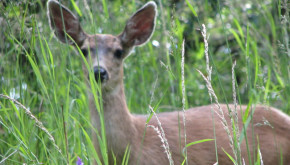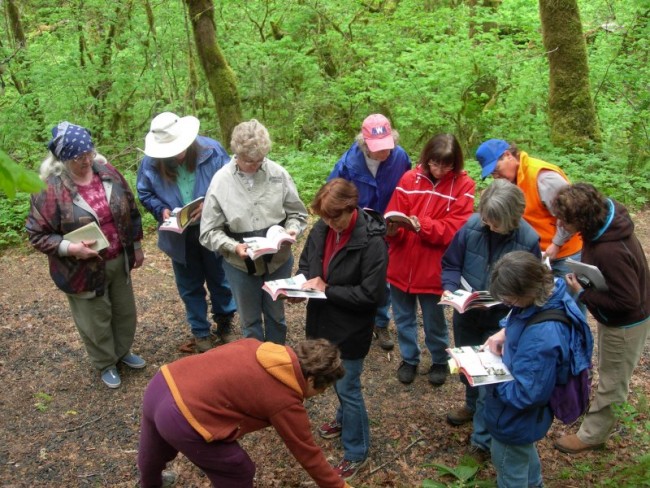
A guest post by Lisa Lee, MS ED, Eden Again Eco-Sanctuary, Salem, OR
At the Oregon Urban Forestry Conference in 2012, we began the day with a keynote speech by Dr. Doug Tallamy, author of “Bringing Nature Home”. I was highly impressed by his talk. His major points included how vital plants are to the entire ecosystem providing forage for insects which in turn feed birds, frogs, squirrels, etc., and are then eaten by larger and larger animals. He also pointed out how native plants have an insect hosting potential far greater than non-native and/or invasive species do. In essence it is up to each of us to contribute to sustaining our local web of life by improving the native ecosystem in our own yards, regardless of its size. Some astonishing facts about our impact on the world were: 1. There is a baby born every 5 seconds in this country. 2. 50,000 acres are deforested everyday in the US for urban development and agriculture! 3. 90% of all insects forage on only 1 to 3 plants.
An Oregon WOWnet native plant ID class. A great was to discover your land's biodiversity!Dr. Tallamy encourages the re-establishment of nature corridors to connect fragmented urban natural areas allowing greater area for foraging. He indicates that biodiversity is essential. “A diverse ecosystem has more niches filled by competing organisms and is able to more successfully resist invasion by alien species.” Redundant species doing the same job increases stability, productivity and are less susceptible to disease. When we shrink habitat, species populations shrink spelling local extinction for tiny habitats. Non-native plants support fewer insects thereby reducing habitat for foraging.
Most insects can develop and reproduce only on the plants with which they share an evolutionary history. For example, the butterfly bush is an alien species to the NW. Although it attracts butterflies, they are unable to reproduce on the bush. A nest of tiny chickadees fledges at 16 days, and requires 4800 caterpillars. A native oak tree can host 564 caterpillars, which would require only 8 ½ trees, whereas a fir can host only 80 and would require 60 trees to feed the same clutch of birds. If there were 25 caterpillars per tree (like a non-native tree), it would require 192 trees. Although we have 30 acres in natural habitat, we may or may not have sufficient forage for the native species we are trying to protect. Fortunately, we are surrounded by other large properties that provide a contiguous natural corridor. It is this large roaming area that allows the deer, coyote, raccoons, etc., in this locale to thrive.
As a result of this conference I am beginning the process of identifying which insects eat what plants. We have already got a large file of native mushrooms and fungi thanks to my husband’s ardent inquisitiveness. We intend to make a study guide for each major sub-system on the property, beginning with the mushrooms. I have begun the wildflowers and plant identification already. We have a number of endangered species. The large animal list is almost finished, with various sightings but few pictures beyond deer and a cougar paw print. We are currently discussing conservation options with the Straub Environmental Learning Center.
In conclusion, we need to encourage our neighbors and friends to plant native plants (and reject imported varieties) and request native plants at our local nurseries. Here are a couple of interesting quotes and web sites you can explore!
“If you want to create ecosystems with a diversity of animal species, we first have to encourage a healthy diversity of plants. It’s simple: By gardening with native plants — no matter where you live or how small or large your space is — you can help sustain wildlife.” www.plantanative.com
Websites of interest: Oregon Explorer - www.oregonexplorer.info
Oregon Department of Fish and Wildlife - www.dfw.state.or.us


